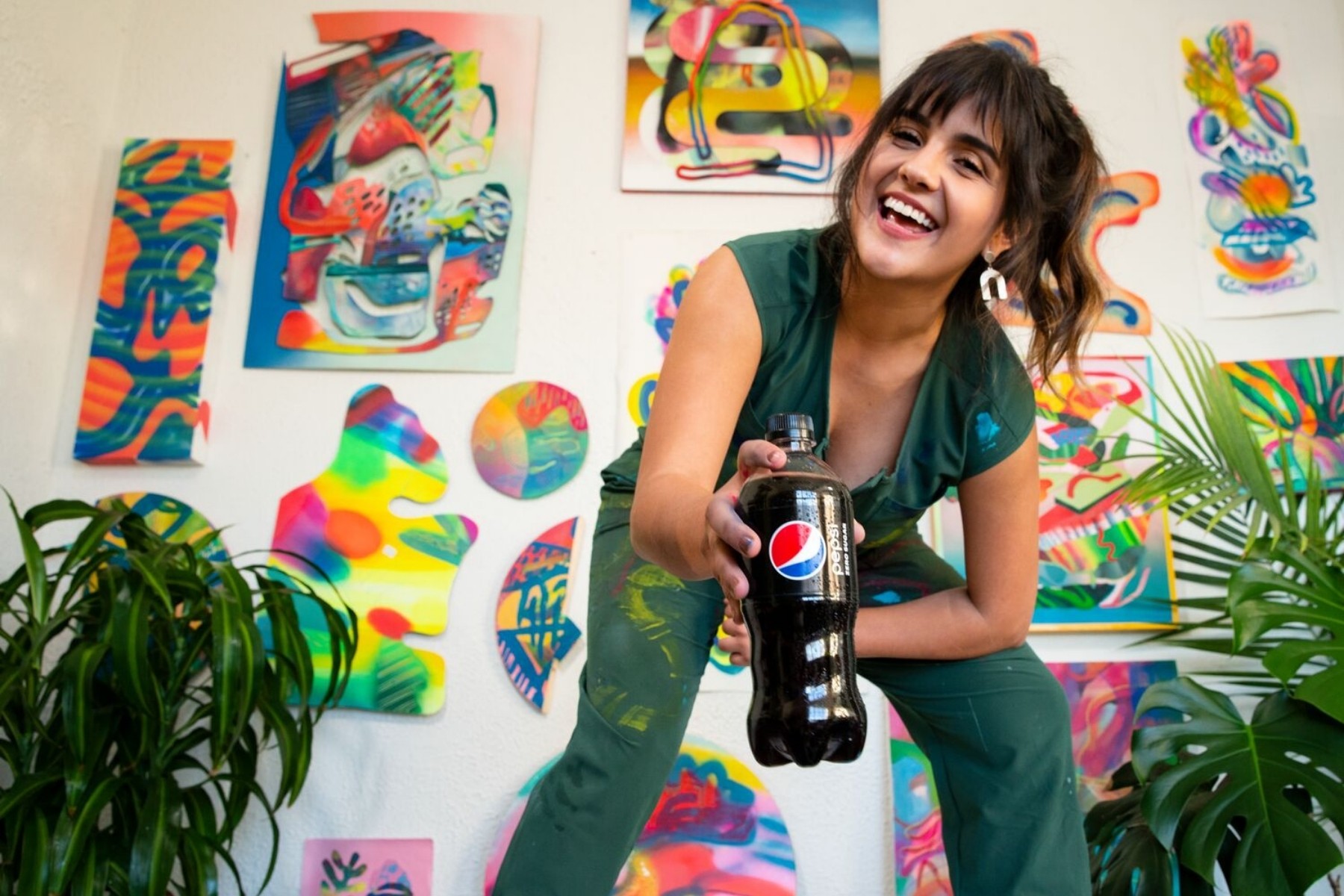Pepsi has chosen Mexican American artist Mariell Guzman as one of the brand’s four Texas Tastemakers, making her part of the brand’s campaign to highlight the variety of the state’s creators. “The Taste of Your Texas” features Austin barbecue pitmasters Eliana & Miguel; Houston rapper Fat Tony; reigning Miss Rodeo Texas, Boerne’s Jordan Maldonado; and Fort Worth’s own Mariell Guzman.
Guzman is a Tejana who represents North Texas. Dallas is a city that is 41 percent Hispanic and 50 percent female-identifying; it’s a good sign of progress when an artist chosen for the national stage is representative of the people. You can find her bright murals on walls and public spaces across the region. During the pandemic, Guzman had enough work to hire a team that includes her mother and sister.
Her mother, Maribel Inzunza Moya, painted walls for a living. But unlike her mom’s more traditional transformations, Guzman brings public spaces to life with an array of colors and designs. She paints public murals, mixed media paintings, illustrations, installations, apparel, and small sculptures. Her large, high-spirited murals seem to emerge somewhere new every other month.
How does she keep her fire from burning out?
“What helps me is to make a trip,” she says. “Going away to nature and being disconnected from everything helps me reset. If I can’t get away, I live by White Rock Lake, so I go there and pretend I’m far away.”
Guzman’s retreat to nature is apparent in her work. Her murals are primarily abstract but manifest into shapes of marine plant life or desert landscapes. Her work is playful, bright, and silly. The expressive murals, which are done primarily with spray paint, have an explosion of color, blobs, and wiggly lines.
Guzman’s mural at Fort Worth’s Grand Berry Theater is the perfect example of this style. The piece covers the top and bottom of one side of the building. Her background is composed of several huge blocks of pastel colors within a range of pinks and oranges and yellows. She then overlays darker blues and greens and and reds in longer, tubular forms reminiscent of algae.
Guzman has an ability to make spray paint look like watercolor, which you can see in those tubes. By outlining her figures with a darker color and filling the inside with pearly iridescent stripes, Guzman gives other organic forms dimension and texture. She pulls in dots, fish scales, animal prints, highlights and shadows. Some lines resemble a horizon at sunset, others look like rivers. Guzman gives us natural references without committing to the full image. It’s brilliantly chaotic but with purpose.
“One of the first artists who stuck with me is Kandinsky,” she says, referring to the Russian painter who pioneered abstract art with bright colors and wild lines. “The idea of making art through spirituality and being inspired by music. And the way of making something that is invisible visible.”
If Guzman’s influence is making the invisible visible, what is she trying to make us see? Does it make a difference that Kandinsky’s abstract art was on the canvas in institutions and Guzman’s abstract work is in the public space?
“I like making art more accessible to everyone. Because museums are expensive and you can’t afford to take the whole family. When it’s outside, it’s free. You can make your connection with it because you can also touch it,” she says. “I love telling people, ‘you can touch it!’ If it has textures, they get so excited. I like that connection.”
In the future, Guzman plans to branch out to textiles, product packaging, and other mediums that would help art exist in people’s everyday lives. She’s interested in forming an art community around the ocean.
“I went to this island with my sister, and we completely fell in love. It has bioluminescence. It’s like you’re looking at stars in the seashore. It’s called Holbox. I want to start an artist residency there,” Guzman says.
Community is a large part of Guzman’s work. She says when people walk by her murals, they can’t help but interact with them. They stick out in public spaces. The viewer stops and uses them as backdrops to their portraits. Others who drive by are transported into a fantasy spiral of the outdoors as they traverse traffic. It adds to the community, which is part of what Pepsi is looking to highlight with its campaign.
The history of murals is tied to politics. They have promoted revolution and lifted up diplomatic figures. Guzman intentionally moves beyond muralism’s propaganda past. Instead, her work acts like a mirror. Her murals urge us to look inside ourselves rather than teach the neighborhood what they should believe. The abstract elements give the control to the viewer: we all see something different in her work.
Guzman is of a lineage of abstract artists who don’t tell people what their work should mean. But that doesn’t mean her personality isn’t a big part of what she produces.
“If I could have my own custom spray paint color, it would definitely be a Mexican pink, the one that’s very traditional to Mexican culture and folk art. It’s one of the most powerful colors.” Guzman says in Pepsi’s Taste of Texas video.
“Mexican pink” or “Rosa Mexicana” is a phenomenon. Mexico City taxis, post offices, government uniforms, and the new official Liga MX soccer jersey are “Mexican pink.” The connection between Mexico, muralism, and abstract art is important.
Last year, the Whitney Museum opened a show dedicated to connecting the influence of Mexican muralism on American art called “Vida Americana: Mexican Muralists Remake American Art, 1925-1945.” Not only is it an acknowledgment of Mexican muralism’s impact on the world, but it widens the restraints on what is “Mexican” or “Latinx” art. It is far more than cliche symbols like roses, tacos, eagles, Selena, and Frida.
It is instead a type of abstraction, similar to how the choice of colors and generous vibrancy make Mariell Guzman’s work unequivocally Tejana.





